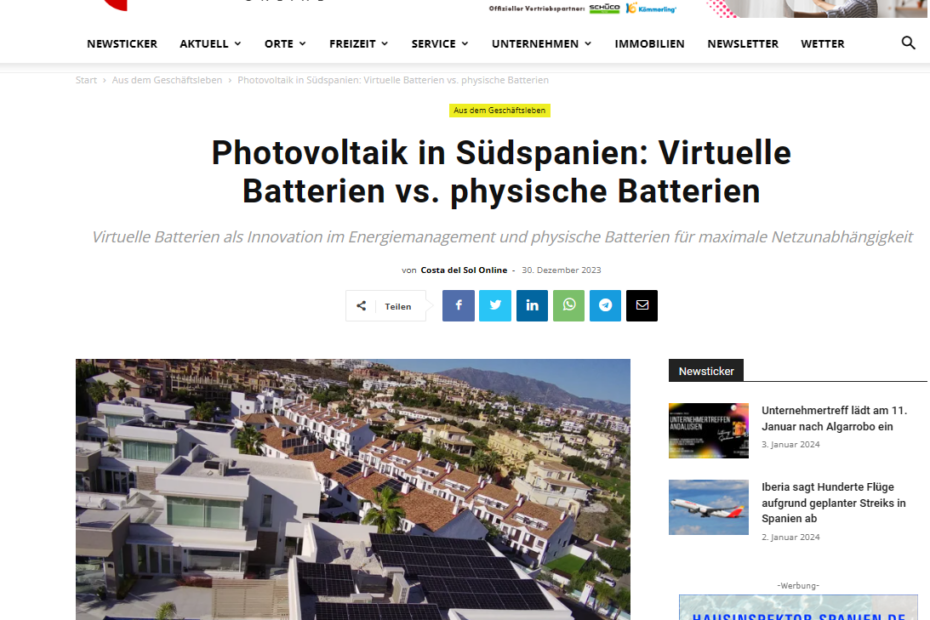What are virtual batteries and how can they be used for solar energy storage? Are they better than their physical counterparts?
These are questions people often ask us since storing the excess solar energy from the installation allows for additional savings. Therefore, we wrote about virtual batteries on our blog and covered this topic in more depth in a recent article for Costa del Sol Online magazine, which you can find here (in German). Below, you have the English version of the same article:
“Virtual batteries enable cost-effective surplus energy utilisation, while physical batteries are more suitable for maximum grid independence and off-grid applications.
This innovative energy solution not only offers an economical way of storing solar energy, but also the flexible distribution of the generated credit to different properties. While physical batteries tend to be off-grid, the virtual version is an affordable way to store surplus solar energy as a credit that can be used and transferred at any time.
In the following interview with Dr Alavirad, Managing Director of RAD ENERGY in Málaga and Oranit GmbH in Karlsruhe, we find out more about the concept of virtual batteries, their advantages, and the circumstances in which a physical battery might be the better choice.
Interview with Dr. Alavirad, Managing Director of RAD ENERGY:
What are virtual batteries and how do they differ from conventional physical batteries?
Virtual batteries are essentially an excellent and cost-effective method of storing surplus solar energy as a credit (not as energy/kWh) that can be used at any time and transferred to your own or other properties. In contrast, physical batteries are better suited for maximum grid independence and off-grid applications.Both battery alternatives are suitable for new and existing solar installations and contribute significantly to reducing electricity bills.
How does the simple compensation regime work and what are the problems with it?
In the simple compensation regime, solar systems produce electricity during the day, part of which is consumed directly by the appliances in the building and the surplus is fed into the grid. This surplus is remunerated with a fixed amount (e.g. €0.10/kWh for a fixed price tariff) or a variable amount (for a free market tariff). For example, you could receive a payment of 200 kWh x €0.10/kWh = €20 for 200 kWh of surplus electricity per month. In this model, the compensation amount is only deducted from the “energy consumption costs” part of the bill until it is reduced to €0.
However, you still have to pay the “potencia” costs (contractual service with the electricity provider) and the taxes on your bill. Another problem is that the credit balance of the surplus can only be used for the billing period (e.g. 35 days) in which the surplus was fed into the grid.
How does a virtual battery work and what advantages does it offer?
A virtual battery is not a physical battery, but a more advanced method of surplus equalisation. The companies offering virtual battery services sell your surplus on the open market, take a commission and store your money in an account. You can use the credit to pay not only the “energy consumption costs” part of your bill, but also the taxes and the “potencia” costs to reduce your bill to 0€. You can also transfer the credit to the next billing periods and pay your future bills.
Another advantage is multi-property utilisation, effortless integration with existing solar installations and the ability to reduce the electricity bill of other properties. For example, if you have a summer house in Málaga and have installed solar panels on it, you can use the credit on your virtual battery account to pay the electricity bill of your main house in Madrid (if both properties have the same electricity provider and virtual battery provider).
Virtual batteries do not need to be physically maintained or replaced as they only exist as a digital credit. Physical batteries, on the other hand, have a limited lifespan and will need to be replaced or repaired at some point.
Are there any disadvantages to using virtual batteries?
Yes, there are some disadvantages. Firstly, you cannot use locally stored electricity in the event of a power failure, as virtual batteries cannot store physical electricity. By selling surplus electricity to virtual battery suppliers, you become dependent on these suppliers when it is necessary to draw electricity from the grid. This can occasionally lead to higher electricity prices compared to other suppliers. In addition, there are also monthly fixed costs of around €3 to €5, plus a commission of 5% to 7% of the added value.
In which cases might physical batteries be the better choice?
Despite the advantages of virtual batteries, there are situations where physical batteries may be preferable or the only option. For example, if you need backup power during power outages, because only physical batteries can provide power in such situations. Physical batteries are also more suitable for off-grid systems or high energy autonomy. They enable on-site storage of surplus solar energy and offer energy independence of up to 95%.
Which electricity providers in Spain currently offer virtual battery services?
Several electricity providers currently offer virtual battery services in Spain, including CyE Energia, EDP, Próxima Energía, Iberdrola, Hola Luz, Factor Energía and Octopus Energy. Each company has its own terms and conditions for virtual battery services.
How can RAD ENERGY help customers decide between virtual and physical batteries?
We help our customers make the best decision for their individual situation: virtual battery or physical storage. A general rule is that a virtual battery is a more viable option if you live in the home with solar for less than 4-5 months. However, if you live there for more than 5 months, a physical battery might be the more sensible solution. You also have the option of linking the two solutions together. Our experts are happy to help our customers make the right choice for their project.”
Let us know if you have more questions or need help with choosing the right kind of battery for you: solar@radenergy.es




